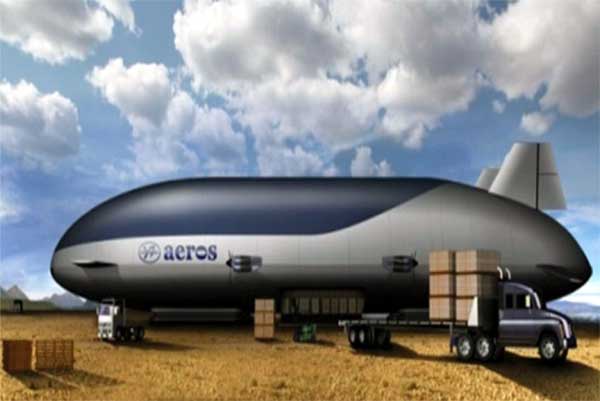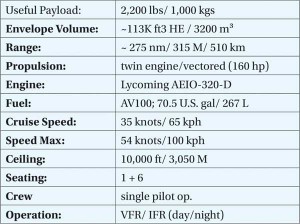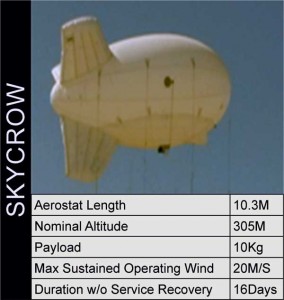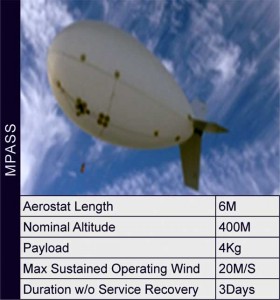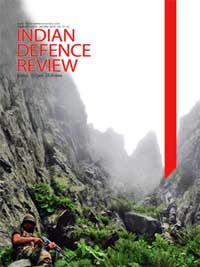Offshore/Naval Airship Applications
Coast Guard/ Territorial Waters Protection – Standing patrols are inherently equipment and manpower expensive. Airships overcome limited visual and sensor search ranges of surface vessels with cost-effective air support, reduce expensive standing patrols, and improve environmental awareness for vessels/ convoys. Airships can maintain over costal and off-shore waters for longer periods, providing documentation and interdiction support
Aeros’ 3200 is an example of a mid-sized aerostat system, similar to but longer than the Akashdeep aerostat system…
Search and Rescue – helicopters are expensive and inefficient for these operations; while airships provide good visibility, long on-scene endurance, low altitude capability, and appropriate search speeds, and can permit survivor rescue by winch or inflatable rescue boat deployment
Anti Submarine Warfare (ASW): Airships can deploy stationary tethered sensor arrays, or tow submerged sonar arrays, with the added benefit of rapid relocation between slow-speed listening positions
Mine Counter Measures (MCM): airships make a great complement to the current use of Unmanned Underwater Vehicles (UUVs) for the identification and neutralisation of naval mines (contact, magnetic, acoustic, pressure), replacing more expensive and vulnerable marine assets as the umbilical connected parent vehicle. Airships can provide longer time on station, and slow, low-level flight characteristics to enhance efficient observation around straits and outside harbors.
40E ‘Sky Dragon’ Airship: Aeros’ latest airship now in production, the 40E ‘Sky Dragon’ builds on the performance strengths of the 40D ‘Sky Dragon’ airships in global operation since 2007 for enhanced multi-role mission capabilities and surveillance/ reconnaissance support. The 40E features flexible payload integration with useful payload up to one tonne; advanced vectored propulsion and control; operational cost efficiency; onboard data workstations or HD downlink for remote operation; and enhanced added levels of safety, pilot empowerment and crew/passenger comfort, and the following performance characteristics:
Unmanned LTA Missions (Aerostats)
Aerostats can generally be categorised into large (strategic), mid-sized (operational) and smaller (tactical) systems.
The Indian Air Force currently employs aerostat-based radar systems for border monitoring on 70M class fixed systems. They lift radars to 15,000 Above Sea Level for better visibility in mountainous terrain to efficiently augment ground and aircraft based early warning detection of moving aircraft or cruise missiles over a wide area. However, mid-sized aerostats can also combine persistent surveillance and robust performance with rapid redeployment capability. Whereas the largest systems have fixed mooring positions, mid-sized aerostats can have integrated mobile mooring stations, providing rapid re-deployment and mission flexibility for the Indian military.
The aerostat system market will experience rapid demand growth during the next five years, growing from $3.93 billion in 2014 to $9.96 billion by 2020…
The military and governmental applications of unmanned, tethered LTA assets (aerostats) are similar to airships. However, their stationary operation and enhanced mission persistence enhance benefits for vigilant area monitoring. Like mobile airships, stationary aerostats provide threat detection early warning solutions through flexible payload integration (radar, cameras, communications and large aperture antenna), supporting military and governmental ISR and security missions, including:
Onshore/Offshore Airborne Early Warning (AEW): long range detection of air and surface targets
- Customs/Border Monitoring: persistent elevated observation with greater cost efficiency, improving line of sight visibility in urban/mountainous areas and over-border observation.
- Port/Harbor Security: aerial observation of onshore/off-shore environment for threats, smuggling or theft; ship-borne deployment provides operational mobility. Aerostats can also be deployed from smaller surface ships and cruise in normal weather, reducing the need for maintaining other aerial assets
- Infrastructure Monitoring: cost-effective monitoring of high value facilities and potential terrorism targets
- Event Security and Safety: quiet and persistent area observation and documentation with benign advertising associations
The benefits of Aeros’ mid-sized and tactical aerostats have delivered to over-border observation, defensive base protection and area observation outside the continental US have transitioned well to other security scenarios where they aid vigilant observation, identification, communication, documentation and interdiction. Aeros has an existing portfolio of solutions that range in size from 6M (tactical) to 39M in length (mid-sized), and also manufactures custom aerostats based on the specific mission requirements such as payload, altitude, wind speed and operating temperatures. Aeros’ production models range in payload accommodation from 9 to 300 kg, and the entire portfolio provides easy field operation and low manpower/maintenance requirements.
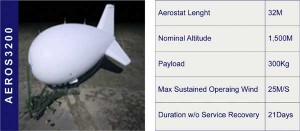 Aeros 3200 – Mid Sized Aerostat
Aeros 3200 – Mid Sized Aerostat
Aeros’ 39-metre length multi-payload aerostat has been designed to provide the full ISR capabilities associated with larger systems, but with the flexibility and reduced logistical footprint of smaller tactical aerostats.
The multi-payload aerostat can accommodate 300-kg payloads at operational altitude of 1,500 M above ground station, with mission duration of 21 days between servicing. The Re-locatable Integrated Mooring System (RIMS) permits full system transport and rapid redeployment, while the integrated remote winch system empowers easy launch and recovery for the operator.
India’s domestic aerostat development continues amid increasing mission demand.
The system provides extended persistent observation and features a powered tether with fibre optic downlink, and integrated moving map software to integrate data into one comprehensive tactical map. The system also features a self-sustained full integrated Ground Control System (GCS) with multi-point redundancy and attached network storage capable of 24 hours of archived surveillance video.
Aeros’ 3200 is an example of a mid-sized aerostat system, similar to but longer than the Akashdeep aerostat system, which may be more familiar to IDR readers (developed by ADRDE for the DRDO of India). India’s domestic aerostat development continues amid increasing mission demand.
The ADRDE is now working on a more advanced version (Nakshatra) with increased payload and longer endurance, expected to enter service next year. Other IDR readers may also be familiar with the large LTA asset, which is also technically an aerostat, used in the opening ceremony of the 2010 Commonwealth Games held in Delhi.
Recent market research suggests that the aerostat system market will experience rapid demand growth during the next five years, growing from $3.93 billion in 2014 to $9.96 billion by 2020, and this growth is being driven by all aerostat size categories, particularly tactical, as well as integration of payloads that support non-traditional missions (from precision agriculture to wildlife monitoring).
Tactical Aerostats
Tactical aerostats are smaller systems that can support ISR and communications for local areas, military installations or individual field-based soldiers. They can serve as a soldier-centric tactical ISR platform, or an advanced portable and quick assembly surveillance system.
Tactical aerostats have more limited payload capabilities due to lower HE volumes. However, advances in lighter payloads developed for drone integration now empower midsize and tactical aerostats with greater capability and cost effectiveness. Aeros has two tactical aerostat production models that can help illustrate the sub-category:
A tactical system, ‘Skycrow’ provides users up to 16 days extend Time-On-Station (TOS), wide payload flexibility, and the benefits of a highly-mobile asset providing persistent surveillance capability with reduced operational support. A turnkey aerial surveillance asset requiring minimum setup and training, at only 10.3 metres long, ‘Sky Crow’ can be deployed rapidly with minimal personnel.
The system integrates payloads for high-resolution electro optics or thermal imaging, communications relays, or other payloads up to 20 lbs.
Easily monitored from a Laptop Control Unit (LCU), the ‘Skycrow’ simplifies dedicated wide-area visual observation, data acquisition and communications support missions, among others.
Aeros’ Man Portable Aerial Surveillance System (MPASS) has been designed for set-up and deployment by a single operator with minimal training requirements.
The system can carry lightweight cameras and payloads to 300M. When vehicle mounted, MPASS can operate whether the vehicle is moving or stationary.
The system remains stable in winds up to 35 knots, and can transfer video data to virtually any video input device. MPASS uses a HD color camera with 5-FOV matched optics, equipped with Automatic Video Tracker to monitor the field of view, and can integrate a 100mW laser pointer Eye Safe Laser Range Finder (ESLRF) for marking targets.
Airships and aerostats generally have reduced acquisition, operational and maintenance costs over comparable ISR aircraft…
Force Multipliers for the IAF
The performance characteristics of traditional airships and aerostats can also serve as significant force multipliers for the IAF, beyond strengthening the air defence environment, reducing operational costs to free budgets for other commands or capability acquisition. Airships and aerostats generally have reduced acquisition, operational and sustaining (maintenance) costs over comparable ISR aircraft. Their speed, operational altitude, range and low and slow capability are simply better suited to certain missions than fixed-wing or rotary aircraft. Beyond long endurance, they provide operational cost effectiveness with both man hour and fuel advantages, have payload volume and flexibility advantages (for radar, cameras, antennae and acoustic detection), and can accommodate relief pilots, and permit onboard data analysis or remote monitoring.
For example, the Dhruv (~$6.3 million acquisition cost) provides greater speed and a longer range at ~ 700 km (vs ~500 km), but with significantly less endurance (< 4.5 hours) than an airship, while consuming significantly more fuel per hour at ~537 litres per hour (L/hr), compared to airship fuel consumption between 30 to 60 litres per hour depending on operations. This pattern continues for other ISR platform alternatives (Si-76C+ ~300 L/hr); (Si-92 ~600 L/hr); (KingAir 350 ~500 L/hr) (G550 variant ~1350 L/hr).
Fixed wing commercial aircraft with comparable useful payloads used for ISR such as the King Air 250/350i (Beechcraft) and rotary aircraft such as the Dhruv or Sikorsky helicopters, require two pilots, while Aeros’ airships can be flown by a single pilot. Sustaining costs are also significantly divergent. The ‘Sky Dragon’ airship from Aeros has a maintenance and spare part contigency of $64 per flight hour, wheras average airframe and engine maintence costs for a helicopter can be twenty times more per flight hour (Si-92 ‘Seahawk’ ~$1,819 per/hr).




